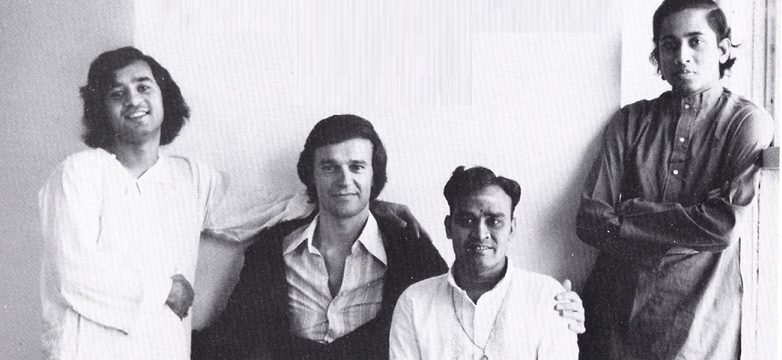
The Birth of a Musical Revolution
In the mid-1970s, legendary Guitarist John McLaughlin, known for his work in Jazz and Rock, found himself drawn to the intricate rhythms and melodies of Indian classical music. His fascination led him to study with Violinist L. Shankar and later with the iconic Sitar (1) master Ravi Shankar (2). With the guidance of Sarod (3) maestro Ali Akbar Khan (4), McLaughlin designed a custom seven-string Guitar to bridge the gap between Western harmony and Indian melodic phrasing. Together with Tabla (5) virtuoso Zakir Hussain, L. Shankar on Violin, and Vikku Vinayakram on Ghatam (6), he formed Shakti—a groundbreaking fusion group blending Indian classical music’s rhythmic complexity with the improvisational spirit of Jazz. Their debut live album, Shakti (1975), captured this electrifying synergy, followed by A Handful of Beauty (1976) and Natural Elements (1977). However, by 1978, with key members departing, the group disbanded, leaving behind a legacy of innovation.
The Return of Shakti
Two decades later, McLaughlin and Hussain reunited, reigniting their shared musical vision. In 1997, they formed Remember Shakti, joined by U. Srinivas, an exceptional Electric Mandolin player, and Selvaganesh Vinayakram, son of Vikku, on Percussion. Their reformation resulted in three albums: Remember Shakti (1999), The Believer (2000), and Saturday Night in Bombay (2001), the latter featuring guest performances from renowned Indian musicians, including Santoor (7) maestro Shivkumar Sharma. In the years that followed, Shakti continued to captivate audiences with their mesmerizing blend of Jazz and Indian classical music, releasing This Moment (2023). This album showcased the evolution of their sound, incorporating newer influences while staying true to their roots in rhythmic intricacy and improvisation.
A Legacy Tempered by Loss
The journey of Shakti has been profoundly marked by the loss of its brilliant members. Mandolin virtuoso U. Srinivas, who had joined the ensemble during its revival, passed away in 2014 at the age of 45 due to complications following a liver transplant. His innovative approach to the Mandolin left an indelible mark on Indian classical and fusion music. More recently, the music world mourned the passing of Tabla maestro Zakir Hussain, who died on December 15, 2024, at the age of 73, from idiopathic pulmonary fibrosis. Hussain's unparalleled skill and passion elevated the Tabla to global prominence, making him one of the most celebrated Percussionists of our time. These losses are deeply felt, yet the spirit of Shakti endures, reminding us of the transcendent power of music and the enduring legacy of these extraordinary artists.
Footnotes
(1) Sitar: A plucked stringed
instrument used mainly in Hindustani music and Indian classical music.
go back
(2) Ravi Shankar: An Indian sitar
virtuoso who helped popularize Hindustani classical music in the West.
go back
(3) Sarod: A plucked string
instrument used in Hindustani music, known for its deep and resonant
sound.
go back
(4) Ali Akbar Khan: A renowned
Indian sarod player and composer, celebrated for his mastery of
Hindustani classical music.
go back
(5) Tabla: A pair of Indian hand
drums used in Hindustani classical music and various other musical
genres.
go back
(6) Ghatam: A percussion instrument
from South India, a clay pot with a unique metallic sound.
go back
(7) Santoor: A trapezoidal hammered
dulcimer, originating from Persia (Iran) and also integral to the
classical music of Kashmir, India.
go back